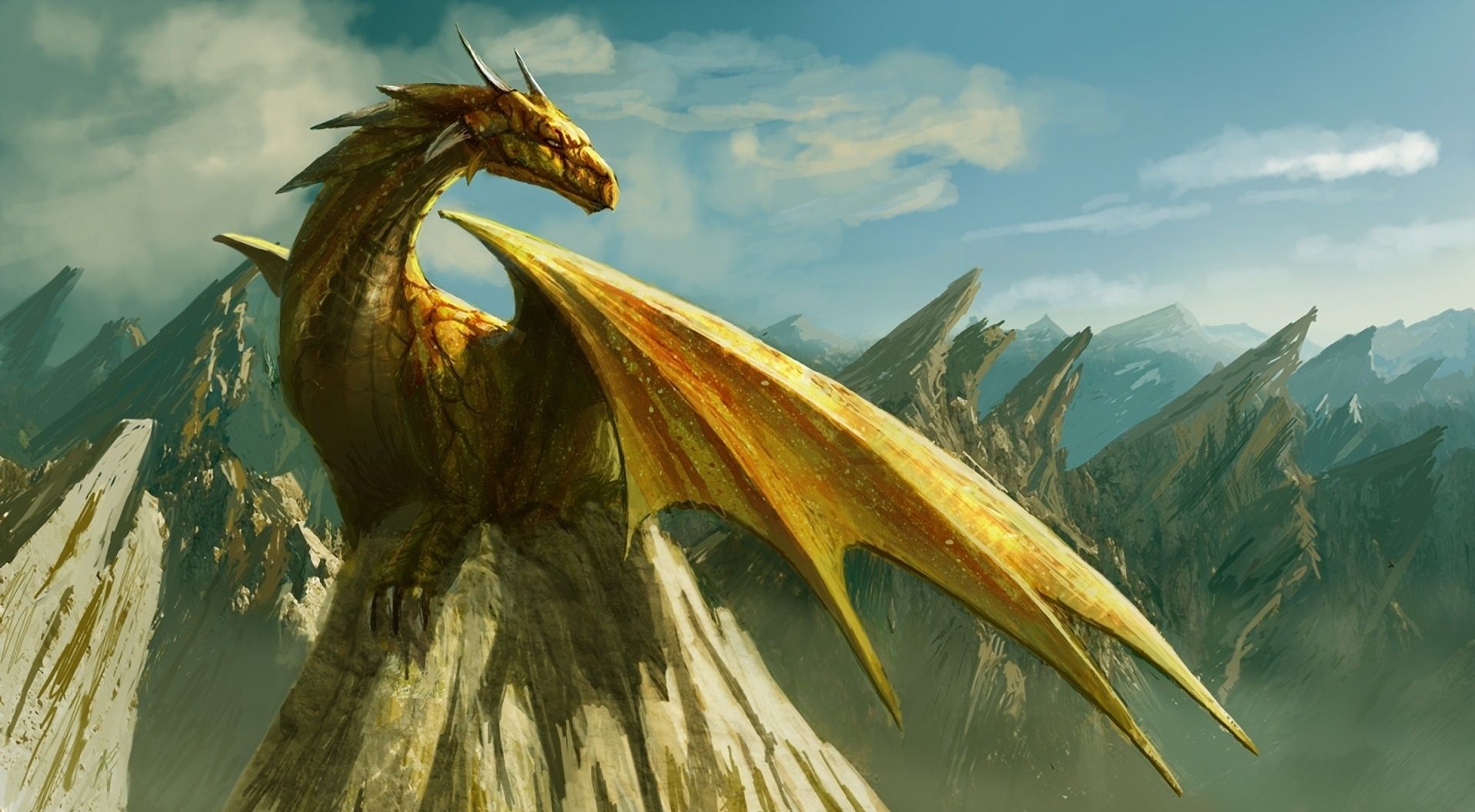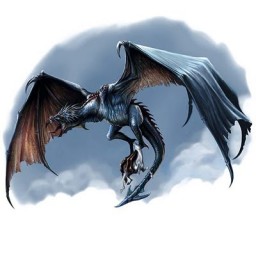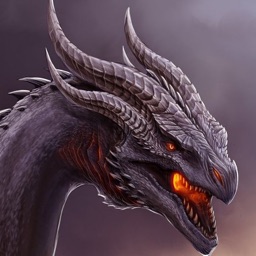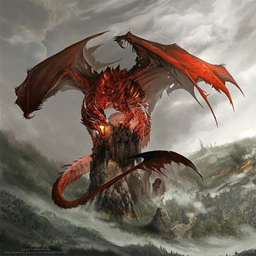Dragon
The Dragon species is one of the most successful species that live on this planet. These usually huge airborne reptiles are found in a myriad of shapes and sizes all across the world, from small docile creatures in the North American forests to gigantic apex predators of the European mountain ranges. They can even come in different variants, such as the quadrupedal true dragons, the more primitive wyvern, the sleek and intelligent asian dragon and so on. Regardless of biology and appearance, all dragons share a common ancestor. It is believed that said ancestor was a type of monitor lizard who ended up heavily mutated . Almost all dragons share several common traits: Reptilian biology (i.e. they lay eggs and are covered in scales), the ability to fly, long lifespans, a natural resistance to magic, a long muscular tail and a fierce disposition. And just like most creatures that came into being after the Day of Fate the species was formed over several generations and magic influence. It is believed that the dragon is the natural evolution of the lizard, but said magic radiation simply sped up said evolution greatly. Regardless of its origins, the dragon is a creature to be feared. Their immense power combined with a generally high aggression level make them immensely dangerous, and if you're unlucky enough to encounter one your odds of surviving are incredibly low.
Basic Information
Anatomy
Due to the success of the dragon species as a whole, they have split off into several smaller groups with key differences to each other. Therefore the most important groups will be described individually.
True Dragons
Wyvern
Asian Dragon
Like their name implies, the asian dragon is found all over the asian continent. They are easily the most unique looking dragon, with traits of snakes, lions, birds and deer mixed together. Their bodies are long and reptilian just like a snake, but with four short legs with five bird-like talons each. Their heads has a similar structure to their true dragon relatives but with a lion-like mane of hair and a set of deer-like antlers adorning them. But their most unique feature is their ability to fly despite lacking wings entirely. They are theorized to be able to ride air currents via a biomagic anti-gravity field, but this is unconfirmed. Their bodies are covered in red,blue, yellow, green or black scales. A typical asian dragon can grow to around 20 meters in length, but very old specimens have been documented to be around 63 meters. However, this is all the confirmed facts we have on the asian dragon. They are very rarely seen, only being spotted occasionally and even then only briefly. We can therefore assume they are elusive by nature, but overall their behavior and biology remains shrouded in mystery.
Drake
Wyrm
Hydra
Biological Traits
Most dragons have their own unique power that little to no other species have. The most famous one is undoubtedly the true dragon's breath weapon. A mature true dragon possesses the ability to spew a stream of magical properties, like flames, frozen air, electricity, acid or venom. The breath type depends on the dragon's colour and habitat; a blue dragon spews electric blasts for example. The dragon owes this ability to an organ called a breath gland located in it's upper throat. Said organ releases a liquid that, upon coming in contact with magic, turns the molecules in the air around its mouth into their elemental property. In other words ignites, superheats or freezes the air etc.. Green and black dragons seem to have a venom gland (green) or acid gland (black) instead, similar to a snake's venom gland. Curiously, the japanese hydra variant seems to also possess a breath gland which enables them to spew electricity. It is unknown why this specific variant mimics the true dragon in this matter when no other dragon does, but like most anomalies on record it's believed to be another mutation.
Wyverns have their own ability that separates them from most other dragons - their potent tail-mounted venom. The venom is produced by a tail gland connected to a stinger, and one sting contains enough venom to kill creatures almost as big as the wyvern itself within minutes. The wyvern itself is immune to it's own venom, so it's strictly a tool for hunting and not for interspecies clashes. But while the wyvern is the most specialized venom user, it is not the only one. Forest dwelling green true dragons have a venomous breath weapon, and the mediterranean hydra has less potent venomous fangs.
Genetics and Reproduction
All dragons lay eggs, but the details vary between versions. True dragons, wyrms and drakes all share the same mating season of late summer to early autumn, all of them lay clutches of between 3 and 5 eggs and all of said eggs takes about 11 months to hatch. The mother violently drives away her mate as soon as her eggs are laid and then protects them with her life until they hatch, where she protects them for their first 3 years before leaving them on their own. Wyverns instead mate right before the winter season and lay up to 2 eggs before hibernating, whereupon the eggs hatch when spring arrives. The mother then protects her young for 8 years, and after that the children leave to find a territory of their own. Hydras on the other hand simply mate in the middle of spring, lay a clutch of up to 10 eggs and then buries the eggs in a hidden spot before leaving them to their fate. These eggs hatch after about 6 months, whereas the newborn hydras need to fend for themselves immediately. Clutches of 7 asian dragon eggs have been found, but nothing is documented about their mating procedures or gestation.
Growth Rate & Stages
Dragons not only grow quickly, they grow their entire lives. True dragons are the most notable example. They hatch as tiny babies, only about 30 cm in length and 2 kg in weight. In 10 years they grow immensely fast up to 35 meters in length and up to 20 tons, and while their growth steadily slows down after that they never really stop. The oldest individuals on record have reached a whopping 150 meters in height - and more than twice that length - and over 120.000 tons in weight. Asian dragons have a similar growth rate. But the only knowledge we have to go off of is a 63 meter long skeleton, so their exact statistics are unknown. The other variants grow even more explosively in their first years, but slow down much faster. To the point that when they reach adulthood their growth is barely noticable for the rest of their life. For example, a wyrm can grow up to 10 meters in their first two years, but after reaching the 20 meter mark they usually only gain half a meter at most past that.
Ecology and Habitats
Dragons live all across the globe in various different habitats. True dragons mainly live in mountainous areas, but some are adapted to forests, deserts, tundras and even the ocean. Wyverns live almost exclusively in mountain ranges, with the exception of the african wyvern who instead lives and hunts on open plains. Asian dragons live only in the tallest mountain ranges above the clouds. Wyrms and drakes mainly lives in forests and open plains, but some live in mountains, underground or around rivers. And hydras live mainly in cavernous underground systems, although all of them - mainly the japanese hydra - can also be found among coastlines. A common misconception is that dragons live in volcanoes. This is only true for certain true dragons and wyrms who are specialized to live in those conditions; any other dragon would be driven away by the immense heat or lack of prey.
Dietary Needs and Habits
All dragons are carnivorous without exception, but the difference is in what prey they hunt. True dragons hunt huge prey such as giants, hadrosaurs and even goristro, although when young they mainly stick with creatures the size of a cow. They usually blast their target with their signature breath weapon to weaken them before slamming them to the ground and finishing them off with a bone-crushing bite to the neck. Wyverns prey on cow-sized creatures their entire life, and hunt similar to hawks; by divebombing their prey and crushing them with its sheer weight and momentum. Hydras eat a bit of everything, and are the only non-aquatic dragons to be partly piscivorous. They mainly hunt by ambushing their target and tearing them apart with their jaws. Drakes hunt faster creatures below their weight class by tiring them out in a chase before biting down their neck, and wyrms ambush similar targets as a wyvern before crushing them by coiling around them. And while we know asian dragons eat huge prey similar to the true dragon, we don't know how they hunt since all we have to go after are dry remains found in a skeleton's stomach area.
Behaviour
No matter their visage or biology, a dragon is highly aggressive by its very nature. Whether it's in a territorial bout or hunting, a dragon shows no restraint towards anything other than its own mate and/or children. Some dragons take this further than others. Asian dragons are believed to be the least violent, due to their very few sightings being very peaceful. True dragons, wyrms and drakes generally don't bother with things of no importance to them (for example a creature too small to eat), but anything it deems as food or a threat will be torn apart viciously. Wyverns are similar, but with an even shorter fuse: If it's even slightly bothered by something it will annihilate it. And hydras have no restraint at all, possibly due to the irritation and energy it takes to handle multiple heads. A hydra spends most of its time on the warpath, killing anything it sets its eyes on.
Additional Information
Average Intelligence
A dragon's average intelligence is frighteningly high. While a wyvern is theorized to be no smarter than its lizard relatives and a hydra only slightly brighter, a true dragon is almost in class with a person. They have been documented to hold grudges, become amused, hunt for sport and even have their own language, somewhere between basic growls and our Common. The people in the city of Akrodon have even taken this language as their own with only minor differences, dubbing it as Draconic. And one brave explorer from the city of Yáoga Pòhzhě claims that asian dragons are much smarter than even humanoids. He claims to have seen them having their own city above the clouds, where they philosophize, form family units and wield magic beyond our understanding. As he explained this very lucidly after having spent hours in extremely thin air, these claims are doubted.
Perception and Sensory Capabilities
A true dragon has extraordinary eyesight and equal sense of smell. Their binocular vision enables them to clearly see objects around 6 km. away, with their eyesight being comparable to a Tyrannosaurus Rex. They can also pinpoint the location of creatures as small as a mouse up to 8 km. away with their sense of smell alone. The hydra variant take these senses to new levels, though. Both the mediterranean and australian hydra have one central brain in its upper body connected to each one of their heads, giving them between 6 and 16 incredibly potent eyes that together can see in every direction at once. The japanese hydra instead has three separate brains - one in each head - that can communicate and share information with each other via a mix of vocalizations and limited telepathy. The wyvern meanwhile has a lesser sense of smell compared to its relatives, but makes up for it with the same astounding vision and an equally impressive sense of hearing - a wyvern can hear the footsteps of a deer from more than 5 km. away.
Scientific Name
Dovah Varanus
Origin/Ancestry
The middle east
Lifespan
Depends on variant, but anything between 70 to 8000 years (possibly longer)
Average Height
Between 0.2 to 150 meters
Average Weight
Between 2 kg to 60.000 tons
Average Length
Between 0.5 to 320 meters
Body Tint, Colouring and Marking
Dragons come in almost every colour, with brown, black, red, blue and white being the most common.






Comments